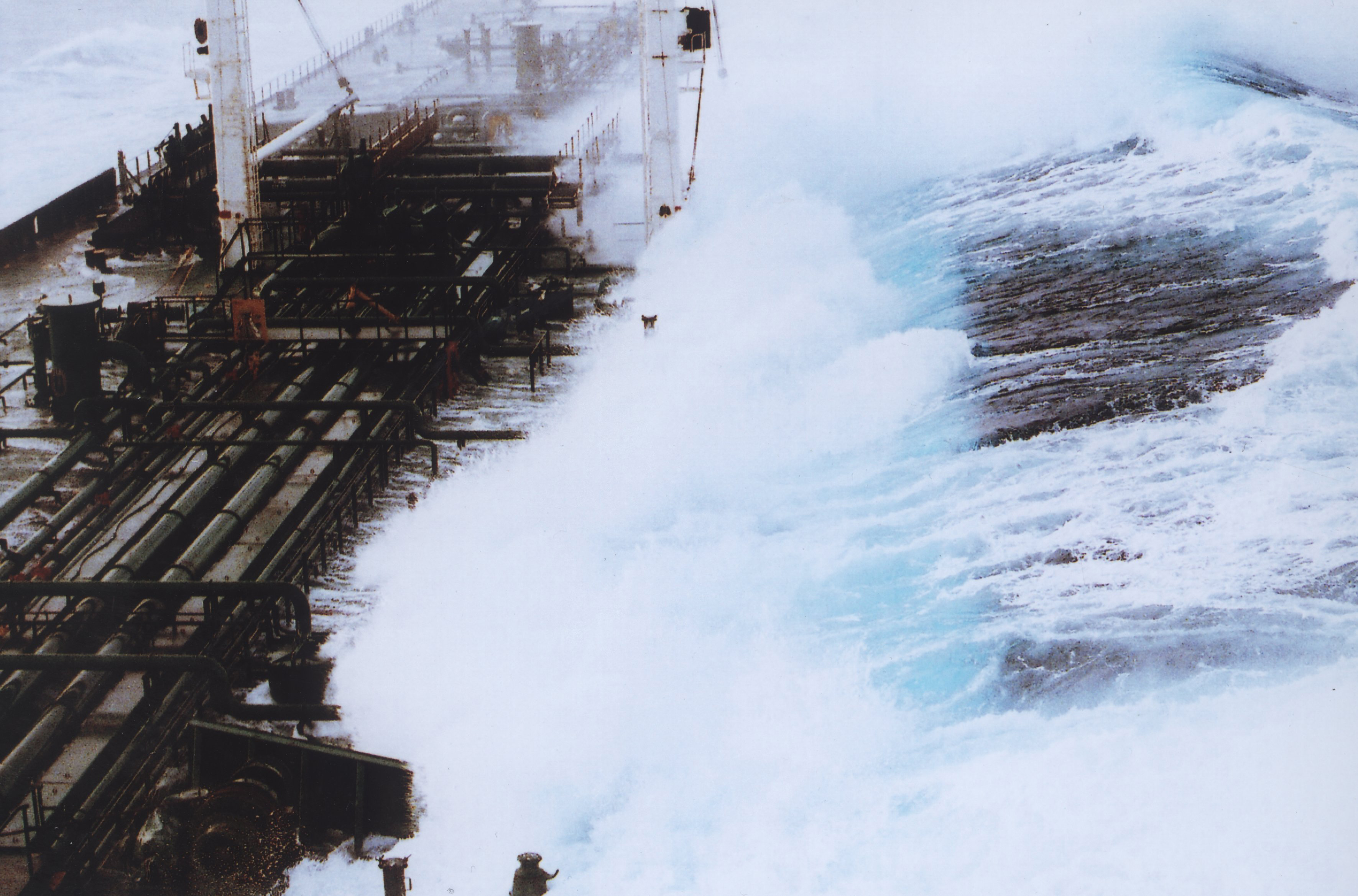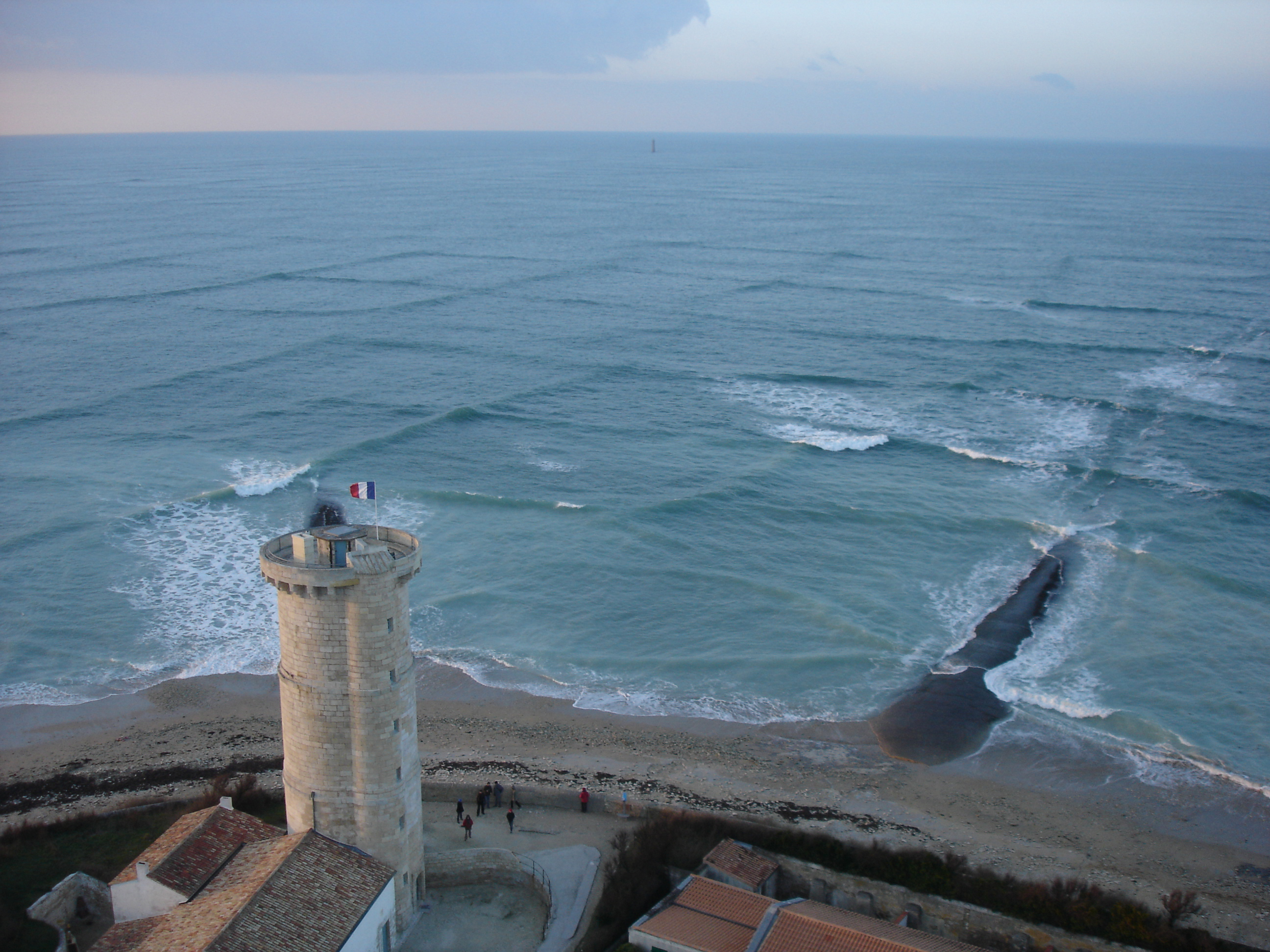
September 2022 (Volume 31, Number 8)
Scientists Create New Way to Predict Rogue Waves in Crossing Sea Conditions
“Rogue” waves—unusual and enormous—pose a threat to ships.
By Margaret Osborne | August 8, 2022

Credit: Captain Roger Wilson/NOAA
A rogue wave more than 60 feet tall, striking a tanker in the Gulf of Alaska in 1992.
For hundreds of years, massive waves in the open ocean—called rogue waves or freak waves—were thought only to be maritime legend. Occasionally, sailors reported these rare waves creating enormous walls in the sea, smashing into ships and swallowing their crews. But many scientists were skeptical and dismissed these tales as exaggerations.
Then, on New Year’s Day of 1995, scientists recorded an 85-foot wave hitting an oil platform off the coast of Norway. This was the first rogue wave ever reliably measured, confirming its legitimacy in the scientific community.
Subsequent research has found that rogue waves—waves twice the height of others around them—are rare, but not that rare: Some scientists estimate that 1 out of every 10,000 waves is rogue.
These waves pose a significant risk to ships and maritime structures because of their massive size and force, but they remain difficult to predict. Now, in a new paper published in Physical Review Fluids, a team of researchers has proposed a novel method to quickly forecast the occurrence and shape of rogue waves in specific conditions.
Over the years, scientists have created models to calculate and predict the properties of ocean waves. One such model, the linear wave model, is a quick and simple way of tracking waves. According to this theory, when two waves combine, they form a large wave twice the height of the smaller ones.
But not all waves in the ocean—including rogue waves—can be explained by linear models. Instead, when two waves meet, energy passes between them in complex and nonlinear ways. Indeed, rogue waves occur because of the “nonlinear interaction between two wave systems,” write the authors of the new paper. These interactions produce high crests and low troughs, the highest and lowest points on a wave.
As a result, rogue waves are trickier to predict. To calculate the probability of a rogue wave occurring, scientists use the Benjamin-Feir Index (BFI), which is essentially the “ratio of wave steepness to spectral bandwidth,” the authors write.
But the BFI has a downfall: It only considers ocean conditions in which waves travel in one main direction. By contrast, many rogue waves happen in what are known as crossing sea conditions, when two wave systems travel at an acute or obtuse angle to each other, explains Xinshu Zhang, professor of naval architecture and ocean engineering at Shanghai Jiao Tong University in China and a coauthor of the paper.

Credit: Michel Griffon/CC BY 3.0
Cross swell visible from Ile de Ré, an island off the Atlantic coast of France.
“There have been several accidents reported, historically, that actually occurred in the crossing sea,” Zhang says. “So that's one of our motivations to study this topic.”
Suspected rogue wave accidents in crossing sea conditions include the Suwa Maru, a fishing boat carrying 20 crew members that sank off the coast of Japan in 2008; the Louis Majesty, a cruise ship off the coast of Spain that was hit with a massive wave in 2010, killing two passengers; and the Prestige, an oil tanker that sunk off the northwest coast of Spain in 2002, spilling nearly 18 million gallons of oil.
To overcome the BFI’s limitation, the authors created a new coupled BFI (CBFI) that can be used in crossing sea conditions.
“It's a very simplified model to rapidly evaluate how dangerous the crossing sea is,” Zhang says. Using parameters that scientists can obtain in advance from weather forecasting systems, the model can predict other wave parameters, and therefore evaluate the probability of a rogue wave happening.
The researchers then validated the model by running simulations and comparing them to past experiments.
“In our simulations, there are thousands of waves,” coauthor Shuai Liu, also from Shanghai Jiao Tong University’s State Key Laboratory of Ocean Engineering, says. “[Imagine] maybe 400 waves propagating in one direction and another 500 waves propagating in another direction. So, we consider lots of waves in these simulations.”
While previous studies focused primarily on the probability of rogue wave occurrence, the authors also considered the shape of these waves.
“The freak wave shape is important to predict the loads on the ships and offshore platforms,” Zhang says. Right now, engineers base their predictions of a wave’s force on a ship or marine platform on the linear theory, he says, which don’t take shape into account.
The study found that wave shape is influenced more by changes to the crossing angle rather than the properties of individual waves.
One constraint of the new CBFI is that it assumes that the two waves in the crossing sea states have the same wave period—the time it takes two successive wave crests to reach a fixed point—which is not always the case. Liu explains, though, that if the two wave periods are the same, it’s most likely to generate a rogue wave.
“We considered the most dangerous conditions, but in the real ocean, it’s not exactly what we assumed in this paper,” Liu says. “That's our future plan, to study more on the effects of the difference of the wave periods.”
Margaret Osborne is a freelance writer based in Utah.
©1995 - 2024, AMERICAN PHYSICAL SOCIETY
APS encourages the redistribution of the materials included in this newspaper provided that attribution to the source is noted and the materials are not truncated or changed.
Editor: Taryn MacKinney
September 2022 (Volume 31, Number 8)
Articles in this Issue
